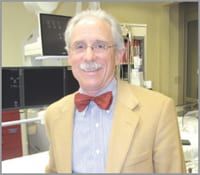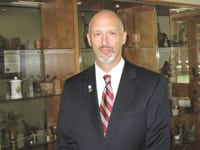It’s About Time Heart-attack Program Strives to Beat the Clock
Tricia Porter opened her smart phone and flipped her way to an EKG (electrocardiogram) forwarded electronically by an EMT responding to a recent 911 call from a man believing he might be having a heart attack.
To the untrained eye, the rows of lines, spikes, and dips don’t mean much. But a cardiologist could take one look and note that the individual in question might have suffered what’s known as a STEMI (segment elevation myocardial infarction), which occurs when one or more of the arteries supplying the heart with oxygen-rich blood becomes clogged. From the world of pop culture, this is what Fred Sanford would have called “the big one.”
And that EKG sent from the ambulance, via a program, or technology, called LifeNet, could save precious time, said Porter, a registered nurse and manager of the Heart & Vascular Program at Baystate Medical Center, adding that, in this business, “time equals muscle,” as in heart muscle damaged by the interruption of blood supply to a part of the heart.
Saving invaluable minutes and seconds is the unofficial mission of the Baystate Regional Heart Attack Program, or BRHAP for short, said Dr. J. Mark Peterman, an interventional cardiologist and director of the program.
“A STEMI can be fatal, even before people can get to medical attention,” he explained. “And it causes damage proportional to the territory — how big the artery is that’s closed — and how long the patient waits to call for help. If people come within an hour and we get the vessel open quickly, we can minimize the damage, but you can’t necessarily take it away.”
And as he talked about that acronym BRHAP, Peterman stressed the second letter.
Indeed, this is a regional program, he told HCN, one that involves all the community hospitals in the area and every entity that would respond to a 911 call. In a nutshell, the program was created several years ago with the goal of getting possible heart-attack sufferers to the cardiac catheterization lab at Baystate Medical Center — the only facility in the region that can perform angioplasty, or the widening of a narrowed or obstructed blood vessel — as soon as possible, and treated as efficiently as possible.
“It all comes down to cooperation, and there are places in the world where people don’t cooperate, or don’t cooperate as well as they should,” he explained, adding that he believes the Western Mass. region and its health care providers have displayed a good deal of what he called “maturity” through participation in the BRHAP.
The success of the program can be measured in a number of ways, and with both words and numbers, said Peterman, starting with the 55-minute median time it takes to get the clogged vessel open again. The national average is about 90 minutes, he explained, putting Baystate’s time in the top 10{06cf2b9696b159f874511d23dbc893eb1ac83014175ed30550cfff22781411e5} among hospitals. As for words, they’re usually from patients remarking about how members of a cardiac team were there waiting for them when they arrived at the hospital, or something to that effect.
But the most telling statistic is the mortality rate from STEMIs, now at about 3{06cf2b9696b159f874511d23dbc893eb1ac83014175ed30550cfff22781411e5} and falling thanks to measures that save precious time. It was roughly 20{06cf2b9696b159f874511d23dbc893eb1ac83014175ed30550cfff22781411e5} in the ’60s, said Peterman, adding that it has come down incrementally over the past several decades thanks to combination of new treatment techniques, including angioplasty, better awareness of the many heart-attack symptoms, the introduction of cardiac-care units, and those all-important efforts to save precious minutes and seconds.
For this issue, HCN takes an in-depth look at the BRHAP, and how this regional approach to the treatment of suspected heart attacks is making a real impact.
Heart-starting Excitement
Peterman said there are many common mistakes that people make when they experience one or more of the classic symptoms that could indicate a heart attack, such as that proverbial ’elephant sitting on my chest’ feeling, or substernal chest pain associated with sweating, nausea, and vomiting.
“Some people will think it’s indigestion and sit on it — they say, ’I’ll wait and see what happens, and if doesn’t feel better I’ll get help tomorrow,” he explained, adding that many individuals go into denial mode when they experience heart-attack symptoms, and sometimes — regrettably — a day becomes several days. Meanwhile, others will drive themselves to the emergency room at Baystate or their local hospital (or have a loved one do it), which is a less-obvious but still critical misstep in what becomes, in actual STEMI episodes (which involve the full thickness of the heart), a race against the clock.
Meanwhile, there are many cases where the symptoms are less obvious, or not present at all, which contributes to hesitation, Peterman continued, adding that, with the elderly, the signs can sometimes be “sinister,” a word he chose carefully. “They may just have a change in mental status or say they feel short of breath,” he explained, “or the blood sugar may go out of whack; they may have minimal symptoms or symptoms that you may not associate with a heart attack.”
The very best course when there is any doubt, he went on, is to simply call 911. This puts the patient quickly in the hands of a trained EMT, one equipped with LifeNet.
“To the extent that a heart attack is ongoing, there’s damage occurring,” he told HCN, “and to the extent that they wait, there’s less salvage of heart tissue.
“This is a time-sensitive treatment,” he continued, “and the time sensitivity is broken into the patient component and the health care component. If the patient sits at home for 24 hours having a heart attack, they may not get as much salvage; in fact, they won’t. Or if they come in quickly and the system doesn’t work properly — which doesn’t happen very often, because we have a great system — either way, if there’s a delay, the patient doesn’t do as well.
“The ideal would be if the patient immediately says, ’maybe this is something bad,’ they wait five minutes, realize it’s not getting any better, and call 911,” he went on. “They’re here in half an hour, we respond, and within 55 minutes, we have their vessel open; that’s pretty darn good.”
Summing things up simply, Porter said the broad goal of the regional heart-attack program is to make that scenario become much more the norm, by continually developing and refining strategies — in realms ranging from education to treatment to prevention — that will help the response teams at Baystate win that race against the clock.
In the Right Vein
LifeNet is an important component of this effort, she explained, noting that the program was introduced roughly a year ago, and has produced tangible results in the quest to shave seconds off Baystate’s time in unclogging blocked arteries — not only saving more lives, but creating better quality of life for the survivors.
In many ways, LifeNet helps get the ball rolling in the cath lab sooner and more efficiently, said Porter, noting that the technology can help teams of specialists know, with a certain degree of certainty, whether and when a patient has suffered a STEMI, and also if the symptoms indicate something else.
“It helps everyone get on the same page,” she said, citing the case of a recent patient, a woman who, like many, marveled that the cardiac cath team was ready and waiting for her when the ambulance pulled into the ER at Baystate. “The EMTs took that EKG in her living room, sent it to our ED, and we knew she was coming at 11 o’clock on a Saturday night, and 20 minutes later, everyone was there waiting for her.”
Of course, the system works much better when the patient experiencing heart-attack symptoms calls 911, as opposed to driving themselves to the community hospital just down the street, which would seem like the logical thing to do.
Taking that latter course might cost the patient 45 minutes or more, said Peterman, because the individual doesn’t arrive at the ER with a sign saying, ’I’m having a heart attack.’ The triage nurse has to assess the patient and attempt to determine if these symptoms indicate a STEMI, indigestion, or the latest flu virus to hit the region.
Overall, the BRHAP is about continually reviewing, updating, and improving technologies and processes, said Porter, with the goal of saving both time and lives.
“We’re working with EMS [emergency medical response] agencies, educating them on better techniques to get patients here faster and more efficiently,” she explained.
“We’ll speak to other health care providers; our program is regional, so we go out to other hospitals and speak with emergency leaders. Those hospitals — Holyoke, Mercy, Noble, and Cooley Dickinson — send all of their STEMIs here, and we have a few hybrid programs at Franklin Medical and Mary Lane, so those hospitals get a lot of education, we go out there for quarterly meetings.”
Since being put in place about four years ago, the regional heart-attack program and its various components have succeeded in bringing down the average time to reopen a clogged artery from about 116 minutes (still well below the current national average) to the present 55, said Peterman, adding that, while the goal is to continually reduce it, speed must be balanced with diligence and precision.
“Speed is most crucial element as long as you know what’s going on and you’re going after the right thing,” he explained. “The problem with going too fast is that you get sloppy; you miss something that you shouldn’t have missed. So there’s a fine line, and I don’t ever see that number dropping much below 50.”
Getting more blockages cleared in the current timely order is the much bigger priority, he said, reiterating that there are many factors involved in the time-sensitive nature of this work, starting with diligence on the part of the patient, as well as that regional aspect to the BRHAP.
Which brings him back to that word cooperation.
“People often ask us how we’ve been able to accomplish what we have,” he told HCN, “and I tell them it wouldn’t be possible without cooperation. Many hospitals [outside the region] think they want to operate for the best of their own program.
“But if angioplasty is the best treatment and it’s only provided here, the other hospitals have to be generous enough to say, ’what’s best for the patient is what’s best for us — yes, we’ll let them go to your hospital.’ And we have that cooperation here.”
The Beat Goes On
As HCN left the cardiac cath lab after an extensive tour, a response team was seen awaiting the arrival of an ambulance with a suspected heart-attack patient.
An EKG had been sent minutes before from that ambulance alerting the team to a possible STEMI. In the fight against time, this battle was already off to a solid start.
Good starts, and finishes, are what the BRHAP is all about — that and the all-important element of time, which does indeed equal muscle.
And that’s the elephant in the room — or, rather, the one sitting on the patient’s chest.



Comments are closed.